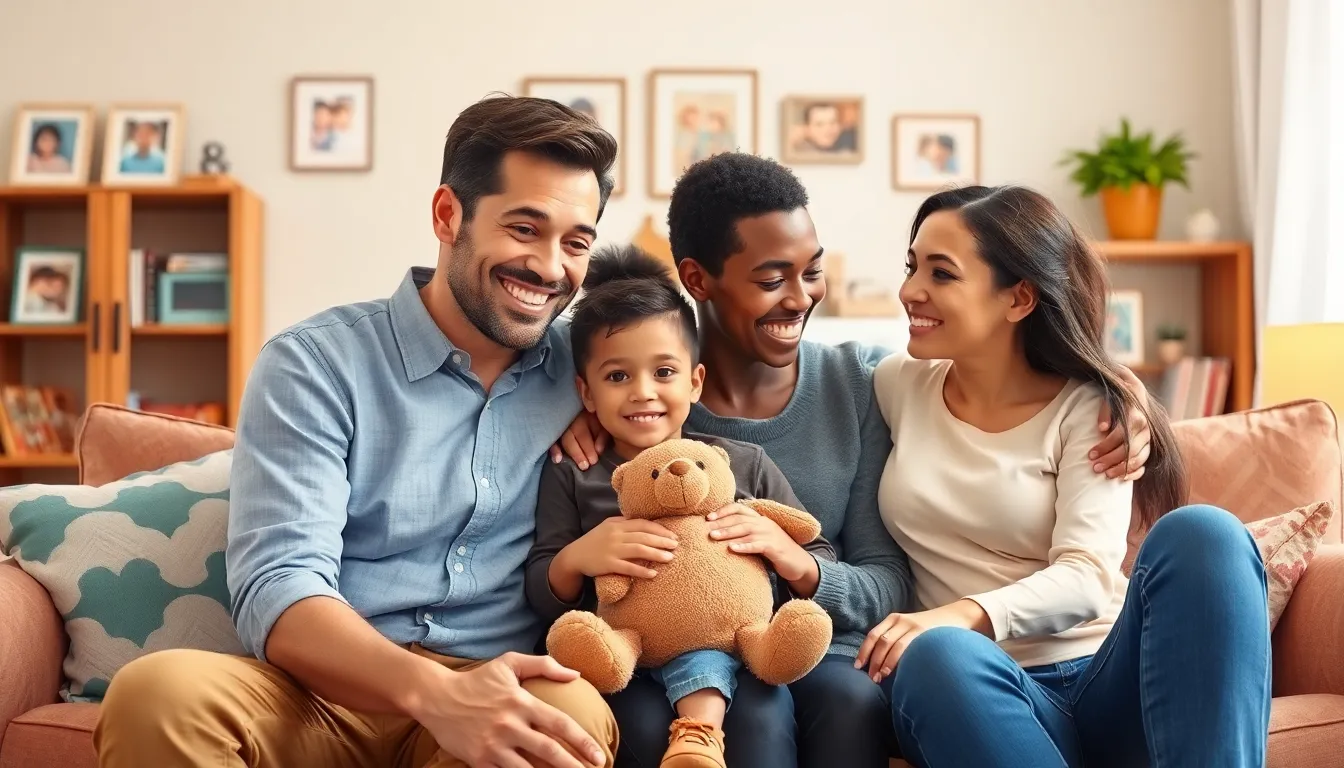Table of Contents
ToggleNavigating the world of child care can feel like deciphering a secret code. Fostering and adoption often get tossed around like confetti at a party, but they’re not the same thing. While both paths lead to providing a loving home for children in need, each has its own unique flavor. Think of fostering as a temporary pit stop on a road trip, while adoption is the ultimate destination.
Fostering offers a chance to make a difference in a child’s life without the long-term commitment of adoption. It’s like being a superhero on a mission, swooping in to provide care and support until the child can find their forever home. On the other hand, adoption is the grand finale, where a child officially joins a family, complete with all the love, chaos, and ice cream parties that come with it. Understanding these differences can help make the right choice for those looking to open their hearts and homes.
Understanding Fostering
Fostering provides temporary care for children in need. Caregivers support these children until longer-term solutions arise.
Definition of Fostering
Fostering refers to a system where individuals take in children who cannot live with their biological families. Participants in fostering may receive financial support from the state. Parents might only need to care for a child for a few days or several months, depending on the child’s situation. Foster homes maintain a connection to the child’s biological family, often encouraging visits.
Purpose of Fostering
The primary purpose of fostering lies in ensuring children’s safety and well-being during a crisis. Safety in this context means offering children a stable environment while addressing their immediate needs. Emotional support plays a critical role in helping children cope with difficult experiences. Fostering also aims to provide a nurturing space, allowing children to develop and thrive until they can transition to permanent placements. The focus remains on reunification with biological families whenever possible, promoting family connections.
Understanding Adoption

Adoption represents a legal and permanent decision where individuals become the parents of a child who is not biologically theirs. This process can involve infants, older children, or even special needs children. Once an adoption is finalized, the adoptive parents gain all parental rights and responsibilities, while the child’s legal ties to their birth family are severed.
Definition of Adoption
Adoption entails a formal agreement that assures permanent placement for a child. This relationship grants legal authority to the adoptive parents and provides the child with stability and security. Various forms of adoption exist, including domestic, international, and foster care adoption. Each type presents unique legal processes and requirements that adoptive parents must navigate.
Purpose of Adoption
Adoption serves several important purposes within society. Primarily, it provides a loving and supportive environment for children in need of permanent homes. The act fulfills the right of children to belong to a family, promoting emotional development and psychological well-being. Furthermore, it grants adoptive parents the opportunity to nurture and raise a child, creating family bonds that can last a lifetime. Ultimately, adoption addresses issues of orphanhood and abandonment by facilitating lasting connections between children and families.
Key Differences Between Fostering and Adoption
Fostering and adoption serve different purposes in child welfare. Understanding these distinctions clarifies the roles they play in a child’s life.
Legal Status
Foster care maintains a temporary legal status for children. While in foster care, a child remains the legal responsibility of the state. Adopting a child, on the other hand, establishes a permanent legal relationship. Adoption severs all legal ties to the birth family and grants full parental rights to the adoptive parents. This legal finality allows adoptive parents to make decisions on behalf of the child without state intervention.
Duration of Care
Fostering typically lasts from a few days to several months. The timeframe depends on the child’s needs and the possibility of reunification with their biological family. Regularly, foster placements can change as the child’s circumstances evolve. In contrast, adoption results in a lifelong commitment. Adoptive parents pledge to care for the child permanently, providing stability throughout their upbringing and beyond.
Parental Rights
Foster parents possess limited legal rights. They provide care but do not automatically gain parental rights over the child in their custody. This limitation allows for the possibility of reunification with the biological family. Conversely, adoption grants comprehensive parental rights. Adoptive parents gain authority to make decisions regarding education, health care, and overall well-being, ensuring the child’s needs are consistently met in a loving environment.
Emotional and Social Aspects
Fostering and adoption involve distinct emotional and social dynamics that significantly influence both caregivers and children. Understanding these aspects can guide those considering each pathway.
Attachment and Bonding
Attachment forms differently in fostering and adoption scenarios. Foster children may struggle with emotional ties due to frequent transitions. Creating bonds sometimes proves challenging when children face uncertainty about their future placements. In contrast, adoption fosters more profound emotional connections. Adoptive parents typically build lasting relationships, offering a sense of permanence and security to the child. Furthermore, adoptive families nurture attachment by consistently providing stability and love, essential for healthy emotional development.
Impact on Children
The impact on children varies significantly between fostering and adoption. Many foster children experience emotional instability, often stemming from previous trauma and the nature of temporary placements. They might exhibit behavioral issues as they adapt to their environments. On the other hand, adopted children benefit from a stable, loving family environment. This permanence helps reduce anxiety and bolsters self-esteem. Long-term studies suggest adoptive children generally experience healthier emotional outcomes compared to those who remain in the foster care system. Stability, security, and a sense of belonging remain critical for promoting positive development in all children, regardless of their background.
Understanding the difference between fostering and adoption is crucial for anyone considering these paths. Fostering offers temporary support to children in need while adoption provides a permanent family connection. Each option plays a vital role in child welfare and has unique emotional and legal implications.
Foster care focuses on stability and safety during a child’s transitional phase, whereas adoption nurtures lifelong bonds and security. Recognizing these distinctions helps individuals make informed decisions about how they can best support children during challenging times. Ultimately both fostering and adoption contribute to creating loving environments that promote healing and growth for children.










